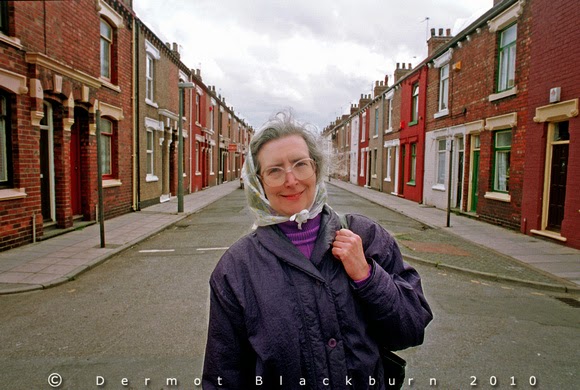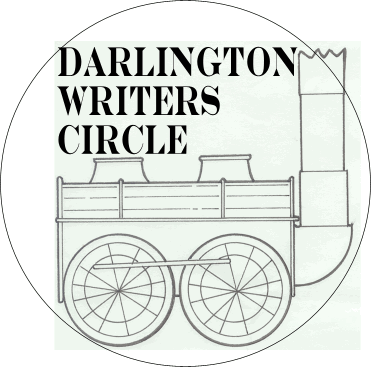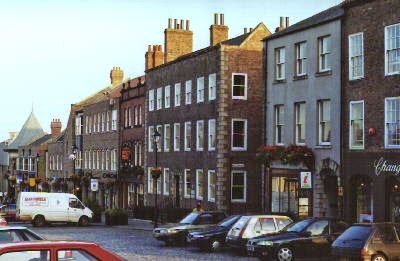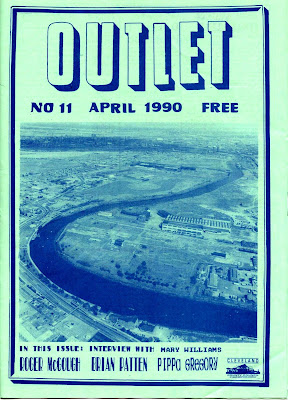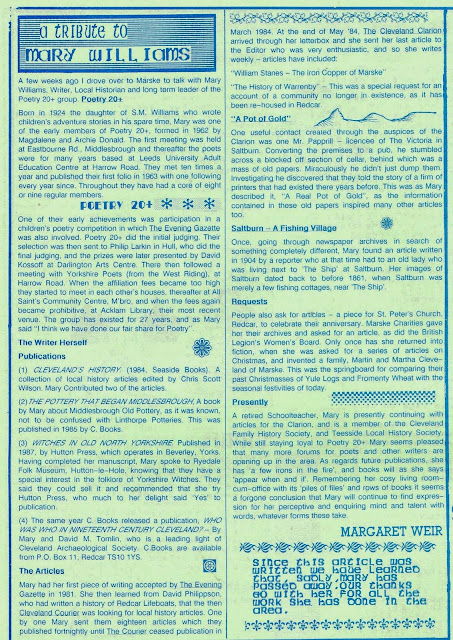The Purple Onion was owned by the enterprising McCoy brothers, Eugene and John, a culinary family, who, at the time,around 1968, also ran the Masham pub but later went on to run the Cleveland Tontine Inn and later still, in the 90’s re-established the Purple Onion as a classy French style brasserie in the heart of the Cultural quarter of Middlesbrough at 72 – 80 Corporation Road. The McCoy brothers had been in a number of bands like The Crawdaddies (more on them later)
Local author, Peter Stockhill recalls ” John Longden was a portly figure,in his forties,who sat scribbling in his notebook in the corner of the cafe. A pendant dangled from his neck.“
 |
| John Miles Longden |
Peter says “The original Purple Onion has a claim to Teesside Literary history, because, in the upstairs room in 1968, John Longden found a refuge in there. He spent many hours, working on his poems at the Purple Onion. John had been writing poems for many years, but only as a sideline of his academic work, but after a nervous breakdown forced him to retire his university work, he returned to his native Teesside and he decided to dedicate himself to his writing.”
Although this was more of a one man group, John, with his academic background, soon attracted a small group of ‘students’ or ‘writers’ around him and as Peter says, John was the nearest Teesside has come to the beat poet Allen Ginsberg.
Who was John Miles Longden?
Dr. Andy Croft tells us (in the introduction to John’s posthumous book- LP’s and Singles -Mudfog 1995) “John Longden was born on 30, March 1921 in London. His father worked in the Civil Service, and his grandfather was an accountant in George V’s royal houshold (as his great grandfather had once been employed in Queen Victoria’s). John liked to think he could remember standing as a very small child on a balcony at Buckingham Palace all dressed up in a little sailor suit,waving to the crowds below!
When John was ten the family moved to Middlesbrough and a large house on Thornfield Road, Linthorpe. He was educated at Friend’s School,Great Ayton,and then at Middlesbrough High School (where he was editor of the school magazine,secretary of the chess club and secretary of the Literary and Philosophical Society). In 1939 he won a scholarship to study PPE (Politics, Philosophy and Economics)at New College,Oxford.There he found himself drawn into the political excitements of those years, secretary of the Cole group and editor of the Labour club weekly paper from 1940 to 1941. In 1940 he joined the Communist party.
During the war he served in the Signals in India and Burma and engaged in famine-relief work on the Ganges delta. After the war he was employed as a Statistician, first in the ministry of Fuel and Power, and then in the Medical Research Council.In 1948 he was elected a fellow of the Royal Statistical Society. Between 1950 and 56 he worked as a research assistant at Cambridge.In 1962 he was appointed Professor of Applied Economics and Statistics at University College, Haile Selassi University, Addis Ababa. Other overseas academic appointments followed at the University of Adelaide,before,in 1967, he returned to the North East to work as Senior Research Assistant at Newcastle University.
It was a distinguished academic career,yet John was prevented from achieving the success that others expected of him because of desperate ill-heath. Suffering from malaria in India in 1943,he was treated with a prohibited synthetic anti-malaria drug, as a result of which he suffered a series of manic-depressive breakdowns. Returning to Teesside in 1968,his last paid employment was as a part-time glassman in the Talbot Cellar Bar in Stockton. John now dedicated himself to writing and painting.”
John Miles Longden the Poet
John Longden was one Teesside’s best loved eccentrics, and a formidable intellectual…he
died in 1993 at the age of 72 and left more than 5000 poems, mostly untyped and almost all of them unpublished.
As Richard Briddon wrote in the the original introduction for John’s book LP’s and Singles – “Many thought that John’s poetry was laughable and eccentric,especially with the missing H’s” but here John explains his own work –
“Poetic forms help me harness and discipline the impulse to write and encourage conciseness.With practice they become second nature.
Classical forms attract me, particularly the Sonnet,the Japanese Haiku, Tanka ‘n Renga and the Elegiacs of Antiquity. Our language is terse ‘n ten English syllables are roughly tantamount to the Japanese Haiku / Senryu’s seventeen, or Elegiac hexameter.
As the forms become natural,these resemblances suggested the idea of using Haiku and Tanka as verse forms,and in due course combining them into what i call the Trivet (Tripod) of seven Tankas,equivalent to seven Elegiac couplets,or one Sonnet – a blend of three classical poetic forms from three cultures and periods….
Aiming,as i have done at a colloquial tone, I have preferred a Northern English style,by which I mean roughly that of Britain north of Brum. This reflects the development of our language beyond the limits of the latinized manderin and computerized cosmopolitan of received standard royal Britspeak which denatures our tongue.
To a degree I proffer a foretaste of the continuing evolution of English -terse,elliptic,and free of the redundant letter ‘H’.This style offers a reminder of the richness of colloquial and Northern speech,and reinforces the conversational tone.
As TS Elliot reminded us, speech must be the basic form of language.Writing and print are derivative ‘n subsidiary and lack the rich resources, the musicality of speech. It was in the centuries that English was unwritten that it became the unique instrument of a unique culture,and latterly the world’s chief international language.This is the language we are bound to serve.” John Miles Longden. From the ‘Sleeve Notes’ to his book LP’s and Singles.
While John had had poems published in local magazines and journals, including Outlet Magazine, Teesside Writers Workshop publications, Thornaby Pavilion Poets publications,Middlesbrough Evening Gazette and I think in one of The Brotton Writers Group’s anthologies, much of his work was unpublished by the time he passed on.
It was the foresight of Richard Briddon in the mid 90’s that led to the posthumous publication of a selection of John’s work. Richard,who had become one of our editors of Outlet and member of the Write Around festival, launched his imprint – Paranoia Press. Unfortunately Paranoia Press folded in 1994 before this project came to fruition and the book was eventually published by another Teesside imprint – Mudfog, under the editorship of Andy Croft.
John Longden’s Contribution to Teesside Literary Scene 1968 – 1993There is no doubt that John Miles Longden had huge influence and involvement in what became a very vigourous literary culture on Teesside. Yet not all of the commentaries about John are correct about the nature of his involvements.
He evolved from his seat in the Purple Onion ‘Caff’ to preside over a small and bohemian group of devotees that met in Middlesbrough’s cafes and pubs as the unofficial ‘University of Cleveland’ before Teesside had any University presence at all. They might meet in the Purple Onion or the the cafe at Middlesbrough station and John’s booming, stentorian voice would deliver informal seminars on any and every subject from Japanese verse forms,the history of number theory, George Bernard Shaw’s phonetic alphabet, wild flowers, African literature,astronomy,Shakespear’s sonnets etc.
In the early 70’s he became a leading light in the The Thornaby Pavillion Poets with Nora Hill and Vincent Mullholland etc. In the early 1980’s, after Ann Wainwright created the Poetic Licence Magazine and co-formed the Castalians, poetry performance gigs at the Dovecot Arts Centre, John and Peter Stockhill got involved along with Johnny Nichol as performers and while Johnny Nichol became compareand they made a contribution, they didn’t, as Andy Croft suggested in the introduction to John’s book, organise the Dovecot events. nontheless, John was always there offering support and reading on stage.
 |
Ann Wainwright with Johnny Nicol and John Miles Longden c 1982 Peter Stockhill behind the camera.
When Community Arts Middlesbrough (CAM) established the Teesside Writers Workshop in 1984, John Miles Longden, Peter Stockhill and Johnny Nichol became members of the Middlesbrough group and indeed formed part of the organising committee but the group itself was an initiative of CAM.
John wasn’t a member of the Outlet Magazine editorial group but did contribute poetry, give great support and did act as an accountant for us when grant aid was reassessed.
The Cleveland Write Around festival was an Outlet initative, a combination of ideas from editors Terry Lawson and Trev Teasdel and others from the team but John suggested the name and designed the logo and joined the committee formally in the festival’s second year, making his influence felt.
John contributed to much of the local literary scene, exerting his influence and making valuable contributions. His efforts weren’t always appreciated or understood and sometimes personality clashed with others and this, on occasions, led to break away groups forming. This wasn’t entirely due to John though, the literary scene was conflicted between what was regarded as an ‘elitist’ approach and the ‘inclusive’ approach of Community arts. The positive side of this ambivalence was the creation of a more diverse literary culture than might have evolved otherwise.
To be continued – revision work in progress Nov 2017
|

 John Miles Longden was also frequenting the Purple Onion in Middlesbrough at this time as describe inCastalians, New Poetry Scene, Teesside Writers Workshop and Write Around. John was published in Outlet also.
John Miles Longden was also frequenting the Purple Onion in Middlesbrough at this time as describe inCastalians, New Poetry Scene, Teesside Writers Workshop and Write Around. John was published in Outlet also. 